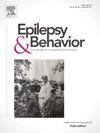Emotional processing in epilepsy: Investigating alexithymia and its associated factors
IF 2.3
3区 医学
Q2 BEHAVIORAL SCIENCES
引用次数: 0
Abstract
Background
Alexithymia refers to the difficulty in identifying and expressing emotions. Although it is frequently observed in patients with epilepsy (PWE), its relationship with the neurological condition remains poorly understood. This review aims to synthesize existing findings on the relationship between alexithymia and sociodemographic, psychological, and epilepsy-related factors in PWE, offering a comprehensive analysis of how these variables interact to influence alexithymia levels within this population.
Methods
The PRISMA guidelines were followed, and a comprehensive search of electronic databases (PubMed, Science Direct) was conducted to identify original research articles published till the end of January 2025 in English. Two reviewers conducted the screening independently. Study quality was evaluated using the Joanna Briggs Institute (JBI) Critical Appraisal Checklist for Analytical Cross-Sectional Studies.
Results
Six studies were included in the review involving 832 PWE. The average TAS-20 score across studies indicates moderate levels of alexithymia across studied populations. Psychological factors such as depression, anxiety, emotional dysregulation, stigma, and suicidal ideation are closely related to alexithymia, while the link between alexithymia, sociodemographic, and epilepsy-related characteristics remains less clear.
Conclusion
Alexithymia is prevalent in PWE, highlighting emotional processing difficulties as a critical yet often overlooked aspect of the condition. The relationship between alexithymia and various sociodemographic, psychological, and epilepsy-related factors is complex and multifaceted. Future research is essential to understand these associations better and to develop targeted interventions that address the emotional and psychological needs of PWE.
癫痫的情绪加工:述情障碍及其相关因素的调查
述情障碍指的是识别和表达情绪的困难。虽然它经常在癫痫患者(PWE)中观察到,但它与神经系统疾病的关系仍然知之甚少。本综述旨在综合现有的关于述情障碍与PWE患者社会人口学、心理和癫痫相关因素之间关系的研究结果,全面分析这些变量是如何相互作用影响该人群述情障碍水平的。方法采用PRISMA指南,综合检索PubMed、Science Direct等电子数据库,检索2025年1月底前发表的英文原创研究论文。两名评审人员独立进行了筛选。采用乔安娜布里格斯研究所(JBI)分析性横断面研究关键评估清单对研究质量进行评估。结果纳入6项研究,涉及832例PWE。所有研究的TAS-20平均分数表明,被研究人群的述情障碍水平中等。心理因素如抑郁、焦虑、情绪失调、病耻感和自杀意念与述情障碍密切相关,而述情障碍、社会人口学和癫痫相关特征之间的联系尚不清楚。结论述情障碍在PWE中普遍存在,强调情绪处理困难是PWE的一个重要但常被忽视的方面。述情障碍与各种社会人口、心理和癫痫相关因素之间的关系是复杂和多方面的。未来的研究对于更好地理解这些关联和制定有针对性的干预措施来解决PWE的情感和心理需求至关重要。
本文章由计算机程序翻译,如有差异,请以英文原文为准。
求助全文
约1分钟内获得全文
求助全文
来源期刊

Epilepsy & Behavior
医学-行为科学
CiteScore
5.40
自引率
15.40%
发文量
385
审稿时长
43 days
期刊介绍:
Epilepsy & Behavior is the fastest-growing international journal uniquely devoted to the rapid dissemination of the most current information available on the behavioral aspects of seizures and epilepsy.
Epilepsy & Behavior presents original peer-reviewed articles based on laboratory and clinical research. Topics are drawn from a variety of fields, including clinical neurology, neurosurgery, neuropsychiatry, neuropsychology, neurophysiology, neuropharmacology, and neuroimaging.
From September 2012 Epilepsy & Behavior stopped accepting Case Reports for publication in the journal. From this date authors who submit to Epilepsy & Behavior will be offered a transfer or asked to resubmit their Case Reports to its new sister journal, Epilepsy & Behavior Case Reports.
 求助内容:
求助内容: 应助结果提醒方式:
应助结果提醒方式:


